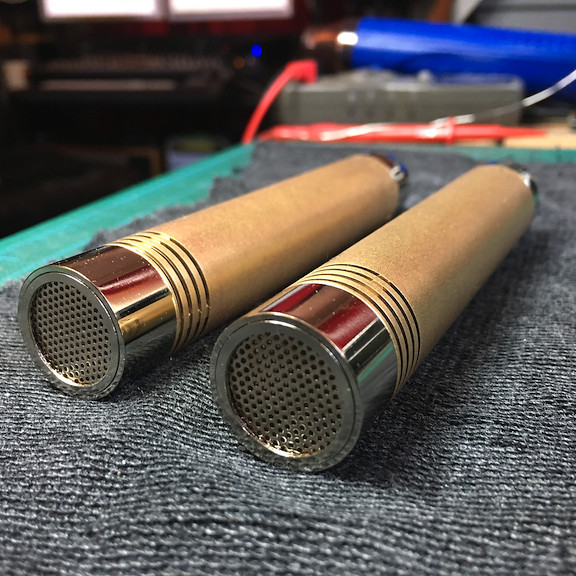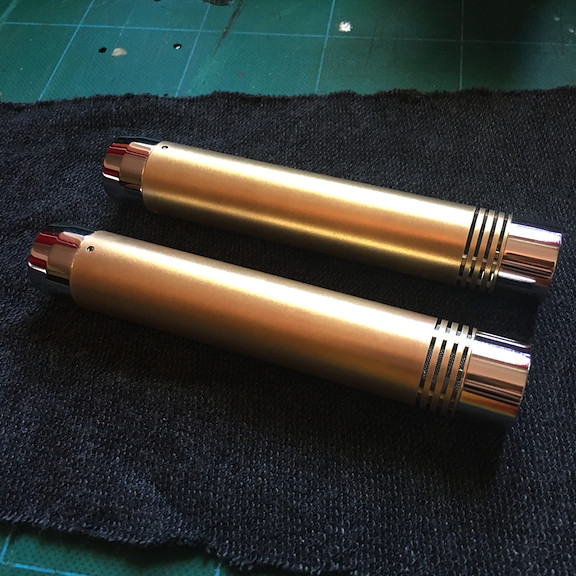For anyone like me trying to find info on how to bias the FET, here's the different techniques I've found so far. I haven't tried any of them yet.
http://www.vintagemicrophonepcbkit.com/Neumann%20U87%20Build.htm
"It’s time to pump a little 48v phantom power into this baby to see what we have cookin! Connect your mic preamp of choice, preferably one that works, and turn on the phantom power. We’re going to calibrate the drain on the microphone to 11.5 volts. Take your multimeter and put the red probe on r6. This is right next to the FET. Take your black probe and put it on the ground hole. Take a small flat-head screw driver and tweak the pot until you measure 11.5 volts. "
http://repforums.prosoundweb.com/index.php/topic,11630.0.html
"I feed a 1K sine wave signal to the gate and slowly increase the source resistance from 0-10k Ohm with a temporary trim pot (10k) until I reach the lowest distortion of the FET.
This will be a pretty precisely defined point right after the highest output of the mic, right after the first heavy distortion audible when the FET turns on, and right before the more gradual onset of the distortion as the FET's output decreases again.
The trick is to feed enough 1k into the gate that at this ideal bias point the distortion is indeed barely audible or gone altogether, and clearly audible to each side of the ideal bias point.
All of this is best done at very low listening levels over headphones in a quiet environment. If you don't want to do it aurally, you can use an oscilloscope.
I then copy the ideal value I found with the trim pot and choose a fixed source resistor of the same value for final installation."
https://groupdiy.com/index.php?topic=46109.40
"First, you set the adjustable source resistor (R7, or the source resistor that is in parallel with the bypass cap C4) to maximum resistance. Then, with the capsule disconnected, you inject a test signal into the coupling cap leading to the gate of the JFET).
Here's a shot of the incoming signal (1kHz, 200mV peak-to-peak in this case). The JFET device is a 2N3819 in this case.
Then you set your scope to AC coupling, and place the scope probe on the drain of the JFET. You then start increasing the input amplitude until one side of the signal begins to flatten out. Here's what this looks like (you can see the top of the signal is starting to flatten):
After this, you decrease the value of the source resistor until the signal again looks symmetrical:
You keep repeating this process (increase input amplitude until one side of the signal distorts, then decrease the source resistance until the waveform looks symmetrical), and after three or four iterations, you'll see that the waveform begins to clip evenly on both the top and bottom of the waveform as you increase the input amplitude. Here's what this looks like:"
http://www.vintagemicrophonepcbkit.com/Neumann%20U87%20Build.htm
"It’s time to pump a little 48v phantom power into this baby to see what we have cookin! Connect your mic preamp of choice, preferably one that works, and turn on the phantom power. We’re going to calibrate the drain on the microphone to 11.5 volts. Take your multimeter and put the red probe on r6. This is right next to the FET. Take your black probe and put it on the ground hole. Take a small flat-head screw driver and tweak the pot until you measure 11.5 volts. "
http://repforums.prosoundweb.com/index.php/topic,11630.0.html
"I feed a 1K sine wave signal to the gate and slowly increase the source resistance from 0-10k Ohm with a temporary trim pot (10k) until I reach the lowest distortion of the FET.
This will be a pretty precisely defined point right after the highest output of the mic, right after the first heavy distortion audible when the FET turns on, and right before the more gradual onset of the distortion as the FET's output decreases again.
The trick is to feed enough 1k into the gate that at this ideal bias point the distortion is indeed barely audible or gone altogether, and clearly audible to each side of the ideal bias point.
All of this is best done at very low listening levels over headphones in a quiet environment. If you don't want to do it aurally, you can use an oscilloscope.
I then copy the ideal value I found with the trim pot and choose a fixed source resistor of the same value for final installation."
https://groupdiy.com/index.php?topic=46109.40
"First, you set the adjustable source resistor (R7, or the source resistor that is in parallel with the bypass cap C4) to maximum resistance. Then, with the capsule disconnected, you inject a test signal into the coupling cap leading to the gate of the JFET).
Here's a shot of the incoming signal (1kHz, 200mV peak-to-peak in this case). The JFET device is a 2N3819 in this case.
Then you set your scope to AC coupling, and place the scope probe on the drain of the JFET. You then start increasing the input amplitude until one side of the signal begins to flatten out. Here's what this looks like (you can see the top of the signal is starting to flatten):
After this, you decrease the value of the source resistor until the signal again looks symmetrical:
You keep repeating this process (increase input amplitude until one side of the signal distorts, then decrease the source resistance until the waveform looks symmetrical), and after three or four iterations, you'll see that the waveform begins to clip evenly on both the top and bottom of the waveform as you increase the input amplitude. Here's what this looks like:"






































